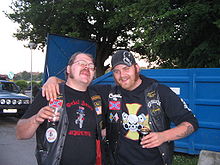Raggare
Loosely translated into English, the term is roughly equivalent to the American "greaser", English "rocker", and Australian "Bodgie" and "Widgie" culture; all share a common passion for mid-20th-century American cars, rockabilly-based music and related fashion (blue-collar in origin, consisting of the likes of white T-shirts, loose fitting denim trousers with rolled cuffs, and canvas top sneakers such as Keds or Converse Chucks, or low-topped boots of an industrial nature).
While the raggare movement has its roots in late 1950s youth counterculture, today it is associated mainly with middle-aged men who enjoy meeting and showing off their retro American cars.
The original phenomenon unleashed moral panic but the contemporary raggare subculture tends to be met with amusement or mild disapproval by mainstream society.
[5] The latest generation of raggare, the so-called pilsnerraggare such as the club Mattsvart who was the subject of the 2019 documentary "Raggarjävlar" ("Greaser scum")[6] do not show much interest in restoring vintage cars, instead opting for driving around in trashed old US cars, drinking alcohol and playing loud music, not necessarily the rockabilly and classic rock traditionally preferred by raggare.
Blue jeans, cowboy boots, white T-shirts, sometimes with print (also used to store a pack of cigarettes by folding the sleeve), leather[8] or denim jacket.
As a result, Sweden's infrastructure remained intact and export economy boomed, which made it possible for the working-class Swedish youth to buy cars, in contrast to most of Europe, which needed to be rebuilt.
[10] When raggare first appeared in the 1950s, they caused a moral panic with concerns about the use of alcohol, violence, high-speed driving, and having sex in the back seat.
One especially infamous raggare gang was Stockholm-based "Road Devils", formed in the late 1950s by Bosse "Gamen" Sandberg (1939-1994), which was very heavily publicized in the press.



